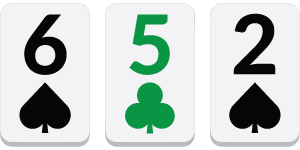No-limit hold’em hand reading is all about putting your opponent on a range and thinking about the structure of that range in terms of how your opponent will be likely to play it. However, it’s virtually impossible to break down a specific list of hands that your opponent could have at the table, since there is just too much information to keep up with. Along these lines, there are shortcuts that you can use to help simplify the process to a degree, and one of those shortcuts is identifying a capped range.
What is a Capped Range?
A capped range is essentially when a range has a clear cut-off or “upper bound” in strength, though it’s usually a term used to describe a range that does not contain any exceptionally strong (nutty) hands. Generally speaking, when your opponent has a capped range and you do not, then you can get an enormous advantage with aggression. Let’s visualize this with two simple examples…
Late Position Call Example
Suppose you’re in a full-ring, no-limit hold’em cash game, and an ABC-style, tight-aggressive player open-raises from early position and you think this player’s range is largely going to consist of things like 77+, AQ+, maybe AJ and maybe KQ. You call in late position, and you see a flop heads-up. This flop comes:

If we think about what the “monster” hands are here, they’re sets and straights at this point, but they could also include monster draws like 8♠ 7♠, and it could even be a two pair hand like 65s. While these hands are definitely in your own range, they aren’t in your opponent’s range. Which means your opponent is capped at one pair at best – while your range can consist of monsters and monster draws more easily.
A Simplified Example
Suppose you’re playing a simplified version of heads-up poker where you can only have an ace, a king or a queen, and the highest card wins. This type of miniature deck of three cards is used for a lot of toy games to demonstrate concepts from game theory. If both you and your opponent can have any of the three cards at random, then you would be on equal footing as far as how the ranges work out
However, what if your opponent was limited and could not have an ace? What if your opponent could only have a king or queen, but you could still have any of the three cards? In this example, your opponent’s range would be capped. While this is more along the lines of a hypothetical example, if you can understand the relationship between the two ranges here with your opponent’s range being handicapped with no aces, then you can directly relate that to actual no-limit hold’em games.
How and Why to Play Aggressively Against a Capped Range
The first feature that’s important to recognize when facing a capped range is that you have a group of super-strong hands that your opponent cannot have. That means that you’ll be able to profitably value bet with many hands at the top of your range simply because your opponent will not have anything better that can ever beat you. This is the crux of the issue for your opponent since it gives your betting/raising ranges the potential to be extremely strong. The first result of this is that your opponent will find himself facing difficult decisions about what to do with medium-strength hands.
Medium-strength hands, in this case the best hands that your opponent will have in his range, are so difficult for your opponent to play here because your betting range can be so strong. If that was the end of the story, then your opponent could just fold all the time without worrying about it. However, if you mix in a good amount of bluffs, then it becomes much more difficult for your opponent to play against you.

Your bluffs and aggression with the weaker hands in your range are the key to exploiting capped ranges. Bluffing a lot in these situations will be what puts your opponent in a bind since he’ll know he can’t just fold all of his medium-strength hands if he doesn’t want to be ran over with your bluffs. On the other hand, a high percentage of your opponent’s range will be weak hands that will have to fold anyway, so your bluffs are going to often just be profitable outright.
When it comes to how your opponent plays his medium-strength hands, which are generally the top of his capped range, it’s a Catch-22 type of situation. If he folds a lot to your likely-strong betting range, then he gets torn apart by your frequent bluffs. However, if he calls a lot of his medium-strength hands to avoid being bluffed to death, then he pays off all of your strong hands. This is a key reason for being aggressive when bluffing against capped ranges.
Know When You Are Capped
While your opponent’s ranges can be capped, there are plenty of spots where your ranges are as well. This isn’t so much of a concern against bad players and players with awful frequencies, but this is a very valid concern against strong hand readers. Make sure you monitor how capped or uncapped your ranges are when playing against good players and stay one step ahead of them. This concept should be used through the lens of range advantage when playing vs good players – to learn more read this “What Is Range Advantage?”
When your range is capped and your opponent’s isn’t, make sure you play more protectively to ensure your opponent can’t just raise you and make your life a living hell. That’s a topic for another article (or video…or complete book lol), but for the time being just be congnizant of the times you are capped vs a good player and remember to pounce when they are capped and avoid getting pounced when you are.
If you enjoy this kind of analysis, you’ll want to check out The Hand Reading Lab. This comprehensive hand reading video course takes you through every facet of hand reading to ensure you always have a grasp on your opponent’s range. There is even a complete video about capped ranges that goes into more detail and really highlights the ins-and-outs of this topic (along with MANY others!). Check out The Hand Reading Lab today and start building the right ranges in every hand!

